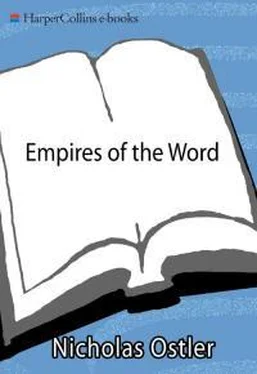Even today, location in the UK provides the best medial point from which to understand speakers of English from all over the world: US, South African, Caribbean, Indian, Singaporean and Australian varieties are all frequently heard on the British media, together with a range of UK regional dialects (notably Scots, Ulster, Newcastle, Liverpool, Yorkshire, Birmingham and cockney); all are assumed to be intelligible to a British audience. The USA, by contrast, has for over thirty years already applied dubbing or subtitles to films in the English of Australia.
It is difficult to attribute this directly either to British or US influence; English was already widely used as a (then neutral) working language of the European Community before UK accession in 1971. But British English remains the majority option when English is taught in Europe.
The 42 million Continentals capable of taking part in an English conversation in 1950 grew to 60 million (18 per cent) over the thirty years to 1980; the figure had reached 80 million (21 per cent) by 1990 and 105 million (31 per cent) by 2000. Taking account of differing competence at different ages—in 1994, 10 per cent of the over-fifty-fives knew some English, but 55 per cent of those between fifteen and twenty-four—Graddol expects the numbers of English-speaking Continentals to peak around 190 million in 2030.
An allusion to Matthew Arnold’s memorable remark, in the preface to Literature and Dogma , that ‘Culture is to know the best that has been said and thought in the world.’ But we are now less committed than Arnold (or Macaulay) to the view that one language can offer privileged access to the whole sweep of human culture.
Phoenician and Hebrew, though neither achieved great expansion, and both were as languages highly alike, are classic cases of language communities on opposite sides of this divide. As for languages such as Akkadian or Aramaic, Nahuatl or Quechua, we know too little about their contemporary societies to place them in this framework.
The first language of African origin is in fact Egyptian Arabic, with 46 million speakers, which ranks it no higher than twenty-third. The different ‘dialects’ of Arabic, of which there are over twenty-five, offer quite solid barriers to mutual intelligibility, so they are well cast in this list as distinct languages. If they are consolidated as a single hyper-language community, united by the elite’s use of classical Arabic as a lingua franca, they would amount to something over 205 million, placing them between Bengali and Portuguese. Those who know classical Arabic number about 100 million. (The distant ancestry of Arabic, like all the Semitic languages, lies in Africa. See Chapter 3, ‘Akkadian—world-beating technology: A model of literacy’, p. 58. The next major African language is Hausa, with 39 million native and secondary speakers.)
The first language of African origin is in fact Egyptian Arabic, with 46 million speakers, which ranks it no higher than twenty-third. The different ‘dialects’ of Arabic, of which there are over twenty-five, offer quite solid barriers to mutual intelligibility, so they are well cast in this list as distinct languages. If they are consolidated as a single hyper-language community, united by the elite’s use of classical Arabic as a lingua franca, they would amount to something over 205 million, placing them between Bengali and Portuguese. Those who know classical Arabic number about 100 million. (The distant ancestry of Arabic, like all the Semitic languages, lies in Africa. See Chapter 3, ‘Akkadian—world-beating technology: A model of literacy’, p. 58. The next major African language is Hausa, with 39 million native and secondary speakers.)
They are better known in the West as Shanghainese and Cantonese.
Nevertheless, its association with Indonesia was strong enough for it to be pointedly discarded as an official language in the new state of East Timor, which has nostalgically opted instead for a return to the language of the earlier colonial power, Portuguese.
Everywhere the situation was complicated by the simultaneous surge in the use of third parties, mostly black Africans, as slaves; to an extent they, or a mix of them and the indigenous population, became the representatives of a new minority community, with the immigrants now the majority. But this slave-associated minority was never divided by language from the majority community, since they had become a community themselves only by adopting some version of the slave-owners’ language.
A little-noted spin-off of this was the first use of printed books as language tutors, initially of Latin. This in turn led to the development of missionary linguistics, originally as an aid to preaching in exotic places (Ostler: 2004).
This can be expected soon to benefit small language communities, as well as the great languages that have been the subject of this book.
However, the nature of the home community is changing, partly under the influence of English. Rising levels of female education, more and more including English, and the prevalence of domestic media such as radio and television, mean that the ‘mother-tongue’ situation for learning a first language in the home will increasingly include English.
Of the forty-eight most heavily used intercontinental flows of telephone calls in 1994, 46.9 per cent (53 billion minutes) were between English speakers. Another 50.4 percent (57 billion) were between English speakers and countries of other languages (figures from TeleGeography Inc., as cited in Graddol 1997: 37).
See Chapter 13, p. 532.
Seventeen per cent (mostly Azeris) are in Iran; 7 per cent are in China (mostly Uyghurs); and 7 per cent (made up of Tatars, Chuvash and Bashkirs, and a variety of tiny groups) are in Russia.
Thai , too, means ‘free’: so the ideal can also be found outside the European tradition.
There is some irony in that this claim is also made by many small indigenous communities for their own languages, which never spread at all.
And on the other side of the coin, when such a language is successfully picked up, but then effaced by another Indo-European language, the evidence may still be seen in deeply alien features surviving three millennia later. This is what was suggested to account for quirks of British Celtic ( see Chapter 7, ‘Rún: The impulsive pre-eminence of the Celts’, p. 292).
Or, more explicitly and technically, diachronic sociolinguistics. Another recent example, largely focused on Africa, is Mufwene (2001 ).
As such, it was recorded in many near-contemporary chronicles. For Motecuhzoma’s words in Nahuatl, I here quote from the contemporary encyclopedia of Aztec civilisation, General History of the Affairs of New Spain (xii.16), compiled by Fray Bernardino de Sahagún, and for Cortés’s in Spanish from the eyewitness account of his serving soldier, Bernal Díaz del Castilla, True History of the Conquest of New Spain (ch. lxxxix).
Sykes (2001, chs 7, 10); Weale et al. (2002). See Chapter 7, ‘Against the odds: The advent of English’, p. 310.
Читать дальше











